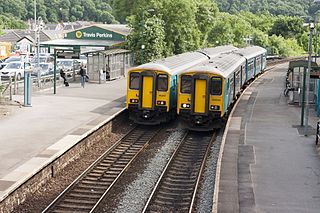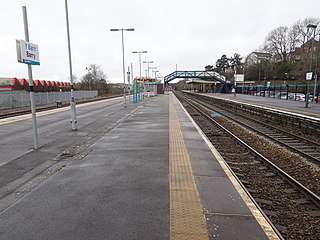Related Research Articles

The Vale of Glamorgan, often referred to as The Vale, is a county borough in the south-east of Wales. It borders Bridgend County Borough to the west, Cardiff to the east, Rhondda Cynon Taf to the north, and the Bristol Channel to the south. With an economy based largely on agriculture and chemicals, it is the southernmost unitary authority in Wales. Attractions include Barry Island Pleasure Park, the Barry Tourist Railway, Medieval wall paintings in St Cadoc's Church, Llancarfan, Porthkerry Park, St Donat's Castle, Cosmeston Lakes Country Park and Cosmeston Medieval Village. The largest town is Barry. Other towns include Penarth, Llantwit Major, and Cowbridge. There are many villages in the county borough.

Bridgend is a town in Bridgend County Borough in Wales, 20 miles (32 km) west of Cardiff and 20 miles (32 km) east of Swansea. The town is named after the medieval bridge over the River Ogmore. The River Ewenny also flows through the town.

The Vale of Glamorgan Line is a commuter railway line in Wales, running through the Vale of Glamorgan from Barry to Bridgend, via Rhoose and Llantwit Major.

Cogan railway station is a railway station serving Cogan in the Vale of Glamorgan, Wales. It is on the Vale of Glamorgan Line 2+3⁄4 miles (4.4 km) south of Cardiff Central on the way to Barry Island and Bridgend.

Barry railway station is one of three stations serving the town of Barry, Vale of Glamorgan in South Wales. This one, Barry Town, is preceded by Barry Docks and Cadoxton stations on the Barry Branch which runs from Cardiff Central to a fourth station at Barry Island, the terminus. Barry is also the junction at the start of the Vale of Glamorgan Line which serves Rhoose and Llantwit Major and terminates at Bridgend.

Llantwit Major railway station is a railway station serving the small town of Llantwit Major, South Wales. It is located on the Vale of Glamorgan Line, 18+1⁄4 miles (29.4 km) west of Cardiff Central towards Bridgend via Barry and Rhoose. The present station opened on 12 June 2005, when passenger services were restored on the section of line between Barry and Bridgend.
The Garw Valley Railway is the trading name of the Bridgend Valleys Railway Company Limited. It operates a short section of 4 ft 8+1⁄2 instandard gauge railway located in South Wales, which is being recreated as a heritage railway. Formerly part of the Llynvi and Ogmore Railway (L&OR) and built by the Great Western Railway (GWR), the line was used for freight and passenger services, with most of the track still in place between Brynmenyn and Pontycymer. The project currently has a train shed at Pontycymer, and hopes to initially offer brake van rides between Pontycymer and Pant-y-Gog, a distance of 0.5 miles (0.8 km).

Cadoxton railway station is a railway station serving Cadoxton and Palmerstown near Barry, Vale of Glamorgan, South Wales. It is located on the Barry Branch 6½ miles (10 km) south of Cardiff Central. The line continues to the terminus of the Barry Branch at Barry Island but from Barry Junction the line also continues as the Vale of Glamorgan branch to Bridgend via Rhoose for Cardiff International Airport bus link and then Llantwit Major.

St. Brides Major is a village within the community also called St Brides Major in the Vale of Glamorgan in Wales.

The Barry Railway Company was a railway and docks company in South Wales, first incorporated as the Barry Dock and Railway Company in 1884. It arose out of frustration among Rhondda coal owners at congestion and high charges at Cardiff Docks as well the monopoly held by the Taff Vale Railway in transporting coal from the Rhondda. In addition, the Taff Vale did not have the required capacity for the mineral traffic using the route, leading to lengthy delays in getting to Cardiff.
In 1861 the Llynvi Valley Railway was opened in Glamorganshire, Wales, to convey mineral products to the Bristol Channel at Porthcawl. It adopted an earlier tramroad, the Duffryn Llynvi and Porthcawl Railway. The Llynvi and Ogmore Railway was opened in 1865, and the two companies amalgamated to form the Llynvi and Ogmore Railway in 1866. At first Porthcawl harbour was an important destination for onward transport, but this soon declined.
The Vale of Glamorgan Railway Company was built to provide access to Barry Docks from collieries in the Llynvi, Garw and Ogmore areas. Proposed by the coalowners but underwritten by the wealthy Barry Railway Company, it opened in 1897 from near Bridgend to Barry, in Wales.

The Ewenny River is a river in South Wales. For most of its 10 miles (16 km) length, it forms the border between the Vale of Glamorgan and Bridgend. It is a major tributary of the River Ogmore, which it joins near its estuary.

The Afon Alun is a river in the Vale of Glamorgan, south Wales. It is a tributary of the Ewenny River, which it joins to the south of Bridgend.

The B4265 road is a main road in the Vale of Glamorgan, southeastern Wales, running in a northwesterly direction along near the coast. It links Cardiff Airport to Bridgend, lasting for 15.9 miles (25.6 km). The road begins at the roundabout near the airport and the village of Penmark at 51°24′21″N3°20′39″W as a continuation of the A4226 road leading from Barry. Passing the junction turnoff to Gileston and St Athan, at Llantwit Major, the B4270 road branches off to the northwest to Llandow Industrial Estate. The road then moves progressively in northwesterly direction until St Brides Major, where the B4524 road to the south connects it to Southerndown and Ogmore-by-Sea. At St Brides Major, the road shifts to a northerly direction, where it passes Ewenny and Ogmore village leading to Bridgend, where it joins the A48 road and finally A473 road at 51°30′7″N3°34′34″W.

Portobello House is a building on the bank of the River Ogmore, about half a mile up from the sea, near the estuary at Ogmore-by-Sea, western Vale of Glamorgan, southeast Wales, on the country border with Bridgend County Borough. It is accessed off the B4524 road. Merthyr Mawr Sand Dunes lie across the river from the house and Southerndown Golf Club lies to the southeast.

St Brides Major is a community on the western edge of the Vale of Glamorgan, South Wales. Its largest settlement is the village of St Brides Major, and also includes the villages of Ogmore-by-Sea and Southerndown, and the hamlets of Ogmore Village, Castle-upon-Alun, Heol-y-Mynydd, Norton and Pont-yr-Brown It is notable for coastal geology and scenery, limestone downlands and fossilised primitive mammals, sea cliffs and beaches, two Iron Age hillforts, three medieval castle sites,, two stepping stone river crossings and a clapper bridge. Three long distance paths cross the community. It is the western limit of the Vale of Glamorgan Heritage Coast, and has a visitor centre and tourist facilities.

The South Wales Metro is an integrated heavy rail, light rail and bus-based public transport services and systems network in South East Wales around the hub of Cardiff Central. The first phase was approved for development in October 2013. Works are currently underway with a brand new depot under construction at Taff's Well and new trains being constructed at the Construcciones y Auxiliar de Ferrocarriles (CAF) 15,000 m2 factory in Newport. This will also include the electrification of the core Valley Lines and new stations. This will be the biggest overhaul to the railways of South Wales since their construction 170 years ago.
Llandow Halt railway station served the village of Llandow in South Wales.
References
Chapman, Colin (1998) The Vale of Glamorgan Railway The Oakwood Press